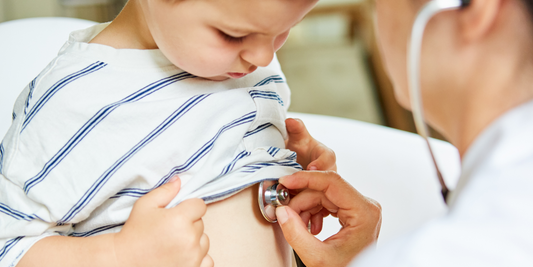
First aid saves life - join in!
Imagine you are the first at an accident site. There is chaos, people call for help and every second counts. At that moment you can be the decisive difference - you can save lives. First aid is not just a fundamental knowledge, it is heroism in everyday life that each of us can learn and apply. Whether in the event of a fall, cardiac arrest or a traffic accident - quick, simple handles can turn the tide and decide on life and death. But do you really know what to do when it matters? The ability to stay calm and act safely makes you an invisible hero. First aid is not complicated - but their effect is often life -changing. Are you ready to act?
What is the day of first aid and why was it introduced?
The First aid day was in the year 2000 of the International Federation of the Red Cross and Red Mountain Company (IFRC) introduced. This takes place annually on the second Saturday in September and serves to raise awareness of the importance of first aid in emergencies. This day, this day is used by various aid organizations and non-profit organizations to encourage people, attend first aid courses and to refresh their knowledge. The goal is to convey the knowledge and skills that are necessary in order to be able to act quickly and effectively in emergencies. It is pointed out that many could be saved if more people were trained in first aid, especially in cases such as cardiac arrests, strokes or traffic accidents. On this day, special actions, courses and public events often take place to spread first aid knowledge and to reduce inhibitions before intervention in emergencies. The day should make it clear that everyone can save lives with the right steps.

In Germany there are clear regulations and regulations that are on First aid courses Relate, both for private individuals and for specific professional groups. These courses are designed to convey basic knowledge and skills in order to be able to help effectively in emergency situations.
First aid courses for the driver's license:
- Mandatory for driver's license applicants: If you want to buy a driver's license in Germany, you have to First aid course complete. This is in the Driving license regulation (FEV) fixed.
- Duration of the course: The course usually lasts 9 teaching units 45 minutes each (about 6-7 hours in total).
- Content: The course covers basic measures such as the stable side position, revival (CPR), supply of wounds and bleeding as well as behavior in the event of accidents.
First aid courses for company first aiders:
According to the Occupational Health and Safety Act and the professional association regulation (DGUV regulation 1), employers are obliged to train a sufficient number of company first aiders.
- Number of first aiders: In companies with up to 20 employees At least one first aider to be available. In larger companies must 10 % of the workforce be trained as a first aider.
- First aid courses for company first aiders: These courses are specifically geared towards emergencies in the workplace and also take 9 lesson units.
- Refresher courses: First aiders must all their knowledge 2 years in one Refresher course Renewing, which also includes 9 teaching units.
- Assumption of costs: As a rule, the costs for training and refresher Professional associations or accident insurance providers.
First aid courses for certain professional groups:
In certain professions, especially in educational, nursing or security-relevant areas, proof of a first aid course is also mandatory. This includes, for example:
- Teacher and educator: These often have to do a special first aid course for children in order to be prepared for emergencies in connection with children.
- Nursing staff: Increased first aid skills are necessary in nursing and in the medical field.
- Sports trainer and trainer: A first aid course is also often required in the sports area in order to be able to act immediately in the event of injuries or accidents.
First aid courses for the general population:
Even outside of professional or legal requirements, it is possible for every citizen to complete a first aid course. Organizations such as the German Red Cross, the Johanniter-Accident Aid or the Maltese regularly offer courses for everyone interested.
- Voluntary refreshment: Although there is no legal obligation for private individuals to refresh first aid knowledge, it is recommended that everyone acquired knowledge two to three years to renew because techniques and procedures can change and knowledge is often forgotten.
First aid measures - what should be done? A step by step instructions
| Step | Description |
|---|---|
| 1. Get an overview | Check the situation to ensure that there are no further dangers. |
| 2. Protect personal protection | Discontinue an emergency call: Call the emergency services and submit all the necessary information. |
| 3. Check consciousness | Address the injured person or shake your shoulders slightly to check awareness. |
| 4. Check breathing | Express the head and check whether the person concerned breathes (see, hear, feel). |
| 5. Bring in a stable side position | If the person concerned is passed out, but breathing, bring him into the stable side position. |
| 6. Execute resuscitation (CPR) | If there is no breathing, start resuscitation immediately (cardiac massage and ventilation). |
| 7. Stop bleeding | In the event of heavy bleeding, put pressure on the wound immediately to stop blood flow. |
| 8. Prevent shock | Keep the affected person warm, calm and constantly monitor it to prevent a shock. |
| 9. Monitor until help arrives | Check the condition of the person concerned regularly until the emergency services arrives. |
Cardiac arrest as one of the most common causes of death in Germany
In Germany, a sudden cardiac arrest occurs annually 50,000 to 65,000 times Outside of hospitals. These cases are as Extra-clinical cardiovascular arrest Described and represent one of the most common reasons for unexpected deaths.
Important facts:
- frequency: The incidence of cardiac arrest is about 60 to 80 cases per 100,000 inhabitants.
- Chances of survival: Without immediate measures, the probability of survival per minute drops by about 10 %. A quick reaction, especially by lay helpers with first aid and the use of defibrillators (AEDS), is crucial.
- Lay resuscitation: Studies show that in Germany only roughly 40 % of the cases of cardiac arrest first aid is provided by lay people present. This number has improved in recent years, but could be further increased.

How do I carry out a cardiac massage?
The Heart pressure massage (also as as Thoracic compression Described) is a life -saving measure that is carried out in the event of a cardiac arrest to maintain the patient's cycle until professional help arrives. It is an essential part of the Cardiopulmonary resuscitation (CPR) And can save lives by maintaining blood circulation and providing the brain and vital organs with oxygen.
This is how a cardiac massage works:
Positioning the hands:
- Place the palm of a hand on the middle of the person's chest (on the breastbone, exactly between the nipples).
- Place the second hand on the first, cross your fingers and make sure that only the palm of your hand puts pressure on the chest.
Hotion of the helper:
- Knee next to those affected.
- Keep your arms stretched so that the strength comes out of your upper body, not just out of your arms.
- Press the chest about 5-6 cm deep (in adults).
- Let the breast basket completely relieve after each pressure so that the heart is filled with blood again.
- The frequency should be at about 100 to 120 compressions per minute lay. A good clue is the rhythm of the song "Stayin 'Alive" from the Bee Gees, which has a suitable frequency.
Breath donation (optional):
- If you are trained and feel able to do so, you can all 30 compressions give two breathing donations. If not, the continuous heart pressure massage alone is sufficient until professional help arrives.
- To the breath donation: overflow the head of the person concerned slightly, close your nose, open your mouth and blow your breasts twice until the chest rises.
- A practical tool is that Emergency ventilation aid.It protects the first aider from direct contact with the patient and ensures that the breathing donation can be carried out hygienically and safely.
Continuation:
- Continue the heart pressure massage until either the patient shows signs of life (movements, breathing) or the emergency services arrives and takes over.
- Change the helper if you are exhausted to maintain the quality of the compressions.
Important instructions:
- Quick action It is crucial: the cardiac massage should begin immediately if no breathing or heartbeat can be determined.
- Do not hesitate: It is better to do something wrong than not to act. Even if the compressions are not perfect, increase the chances of survival of the person concerned.
- Automated external defibrillator (AED): If an AED is available, it should be used immediately. It gives clear instructions on how and when shocks should be administered.
- For these emergency situations there was a Resuscitation designed.
This product supports first aiders in carrying out heart-lung resuscitation (CPR). There are visual and tactile instructions to ensure the correct position of the hands on the chest and the right pressure on cardiac pressure massage. The lifepad is specially designed for emergency situations to increase the chances of survival. You can do this product in your First aid Keep the set so that you have this in emergency situations at hand.
First measures in a stroke (apoplex)
The Time Is in a stroke decisive - It plays a vital role in the chances of survival and avoiding permanent damage. The reason for this is that a stroke affects the brain and brain cells die at the moment when they are no longer sufficiently supplied with oxygen and nutrients. The faster a stroke is treated, the greater the chances of saving the life of the person concerned and preventing permanent disabilities.

Why is time so important?
Loss of brain cells:
- At a Ischemic stroke (caused by a blood clot) die per minute approx. 2 million brain cells away. This means that the longer the stroke remains untreated, the more damage in the brain.
- Early intervention can limit the damage and significantly increase the chances of complete recovery.
The time window for treatment:
- The treatment options, such as the Thrombolysis (Dissolution of the blood clot by medication) are only effective within a limited period of time - usually within 4.5 hours After the start of the stroke.
- One mechanical thrombectomy, in which the blood clot is removed mechanically, in certain cases up to 6 hours possible after the stroke, and in some cases up to 24 hours, depending on the severity and the affected brain areas.
The concept of the "golden hour":
- Similar to a heart attack is the so -called Golden hour - the period immediately after the stroke - of the greatest importance. The earlier the patient receives professional help during this time, the greater the chances of survival and the less the risk of permanent disabilities
Irreversible damage:
- After a few hours without treatment, the brain damage caused by the stroke is often irreversible. The likelihood that the person concerned must live with permanent physical or mental restrictions is increasing.
Measures to minimize the time delay:
- Early detection: The Fast scheme (Face, Arms, Speech, Time) helps to recognize strokes at an early stage so as not to lose valuable time.
- Immediate emergency call (112): If a stroke suspected, the emergency call should be chosen immediately. Fast professional medical care can save the life of the person concerned.
What are you waiting for?
First aid is not a mandatory program - it is an act of charity. It shows that we are there for each other when it counts the most. After all, it's about saving human life. So ask yourself: Are you prepared? If not, use the opportunity and freshen your knowledge. Because in an emergency, every second counts, and you could be the one who makes the decisive difference.






























